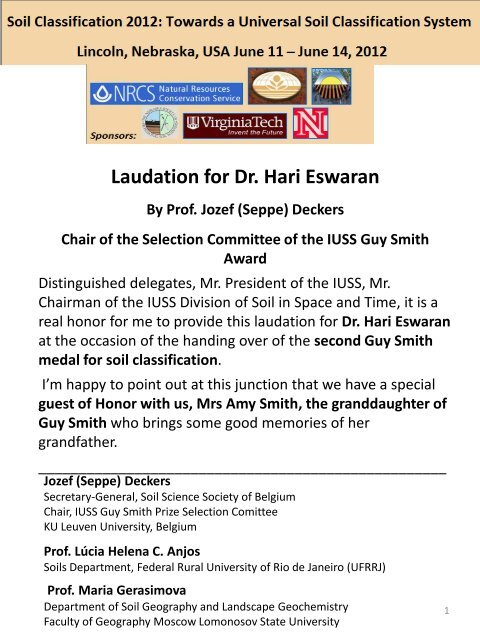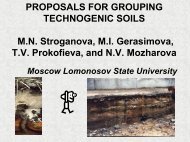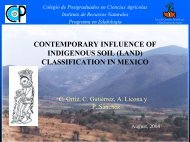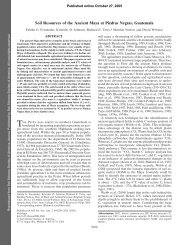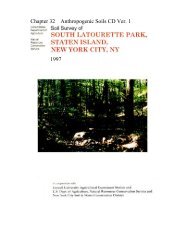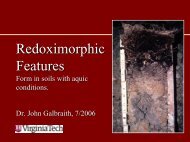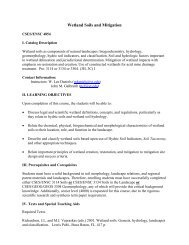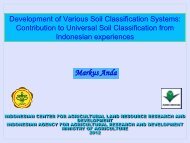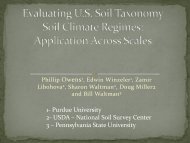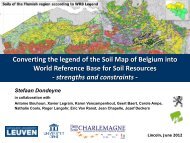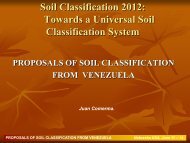2012 2nd Guy Smith Medal Award Presentation
2012 2nd Guy Smith Medal Award Presentation
2012 2nd Guy Smith Medal Award Presentation
You also want an ePaper? Increase the reach of your titles
YUMPU automatically turns print PDFs into web optimized ePapers that Google loves.
Laudation for Dr. Hari Eswaran<br />
By Prof. Jozef (Seppe) Deckers<br />
Chair of the Selection Committee of the IUSS <strong>Guy</strong> <strong>Smith</strong><br />
<strong>Award</strong><br />
Distinguished delegates, Mr. President of the IUSS, Mr.<br />
Chairman of the IUSS Division of Soil in Space and Time, it is a<br />
real honor for me to provide this laudation for Dr. Hari Eswaran<br />
at the occasion of the handing over of the second <strong>Guy</strong> <strong>Smith</strong><br />
medal for soil classification.<br />
I’m happy to point out at this junction that we have a special<br />
guest of Honor with us, Mrs Amy <strong>Smith</strong>, the granddaughter of<br />
<strong>Guy</strong> <strong>Smith</strong> who brings some good memories of her<br />
grandfather.<br />
___________________________________________________<br />
Jozef (Seppe) Deckers<br />
Secretary-General, Soil Science Society of Belgium<br />
Chair, IUSS <strong>Guy</strong> <strong>Smith</strong> Prize Selection Comittee<br />
KU Leuven University, Belgium<br />
Prof. Lúcia Helena C. Anjos<br />
Soils Department, Federal Rural University of Rio de Janeiro (UFRRJ)<br />
Prof. Maria Gerasimova<br />
Department of Soil Geography and Landscape Geochemistry<br />
Faculty of Geography Moscow Lomonosov State University<br />
1
Let me start by providing some background on Hari’s<br />
Eswaran’s personal history and professional career. He<br />
was born on January 28, 1941 in Kluang, Johore, Malaysia.<br />
He obtained his M.Sc in Soil Survey in 1967 at the<br />
University of Ghent, Belgium where he also graduated with<br />
a PhD in 1970 under the guidance of the renown Prof. Dr.<br />
R. Tavernier, a personal friend of <strong>Guy</strong> <strong>Smith</strong>. Hari stayed on<br />
in Belgium at the International Training Centre (ITC-Ghent)<br />
as lecturer and scientific collaborator till 1976.<br />
In the early eighties Hari Eswaran went to Honolulu at the<br />
University of Hawai for leading an USAID project on Soil<br />
Management Support Services (SMSS). The idea of the<br />
SMMS project was to provide assistance to developing<br />
countries to come to grips with Soil Taxonomy for mapping<br />
and classifying soils. Within this programme Hari reached<br />
many young soil scientists from all over the world during<br />
the field training sessions. Some 90 countries benefitted<br />
from this project. 12 international committees INCOMOX,<br />
INCOMANTH, etc., were established bringing some 1200<br />
soils scientists under one roof, reflecting on soil genesis<br />
and classification. The project received honors and awards<br />
from different countries (Van Ranst, 2011).<br />
2
In 1986 Hari was elected Vice-Chairman of Commission V<br />
of the ISSS and in that capacity he shaped the Benchmark<br />
Soils Project.<br />
As of 1989 till 2009 Hari was the National Leader of the<br />
World Soil Resources Centre of the USDA Natural<br />
Resources Conservation Service. He developed a program<br />
and coordinated activities of international technical<br />
exchange and assistance in areas of soil resource<br />
assessment, monitoring and management (Van Ranst,<br />
2011). The result of this work culminated in the production<br />
of the 1:30 million map of the ‘Soil Regions of the World’.<br />
He also developed a global soil database which has been<br />
used world-wide for assessing soil qualities and impact of<br />
land degradation. Last but not least he was one of the forerunners<br />
in designing ‘Sustainable agriculture’ by soil type<br />
and spearheaded studies on ‘Global change and<br />
desertification’.<br />
Hari has published numerous scientific journal papers,<br />
served as reviewer of some 7 SCI journals. Among the<br />
many symposia Hari organized, the one of 2003 at<br />
Charlotte–USA during the Annual meeting of the<br />
American Soil Science Society was particularly important<br />
in view of its contribution to international soil correlation.<br />
It was published as a book: 'Soil Classification, A global<br />
Desk Reference' by the CRC Press.<br />
3
Let me now further elaborate upon Hari’s major<br />
contributions to soil classification.<br />
Prof. Van Ranst (2011) wrote: ‘Dr. Eswaran’s greatest<br />
contribution has been the improvement, understanding,<br />
and use of ‘Soil Taxonomy’ globally. He led the creation of<br />
several international committees (e.g. ICOMOX, ICOMID,<br />
ICOMAND,...), open-ended groups that brought the world’s<br />
leading soil experts together to improve aspects of Soil<br />
Taxonomy. Under his leadership, these committees<br />
provided recommendations that led to a series of<br />
universally accepted updates, including the establishment<br />
of two new orders, the Andisols and Gelisols, and the<br />
publication of periodic issues of “Keys to Soil Taxonomy”’.<br />
As ex-chairman of the IUSS World Reference Base for Soil<br />
Resources (WRB) working Group I have witnessed Hari’s<br />
true love for soils. He joined us wherever WRB would take<br />
him, China, Vietnam, Italy, Germany etc... In the profile pit<br />
he is a master to open the pit like a book, meticulously<br />
unfolding its pages and explaining its true content to all<br />
young scientists clustering around him.<br />
4
Thanks to Hari the WRB working group developed a<br />
rationale for the WRB system, and in doing so we realised<br />
that a simple system of two categorical levels with great<br />
flexibility of the qualifiers would make an easy, useful and<br />
true classification system ready for international soil<br />
correlation and mapping. He also favoured congruence<br />
between Soil Taxonomy and WRB so as to improve the<br />
scope for international soil correlation.<br />
Upon the launching of the call for the second <strong>Guy</strong> <strong>Smith</strong><br />
Prize, the selection committee received numerous<br />
nominations. After a thorough scrutiny of the submissions<br />
by the <strong>Guy</strong> <strong>Smith</strong> Committee, Dr. Hary Eswaran came out<br />
as the strongest candidate. Incidentally, Hary Eswaran is<br />
stepping in the shoes of the great Rudi Dudal who was<br />
awarded the previous <strong>Guy</strong> <strong>Smith</strong> Prize. Incidentally, Hari<br />
supported Rudi Dudal in bridging different soil classification<br />
systems in the implementation of the Soil Map of the<br />
World.<br />
May I now request Prof. Karl Star Chair of IUSS Division of<br />
Soil in Space and Time, to hand over the <strong>Guy</strong> <strong>Smith</strong> prize<br />
to Hari Eswaran.<br />
_____________________________________________________________<br />
Acknowledgement: for this laudation I gratefully used factual information<br />
on Hari Eswaran drawn from the article in PEDON No 22, January 2011<br />
(Newsletter of ITC-Ghent, Belgium) with kind permission of its author Prof.<br />
Dr. Eric Van Ranst<br />
5


